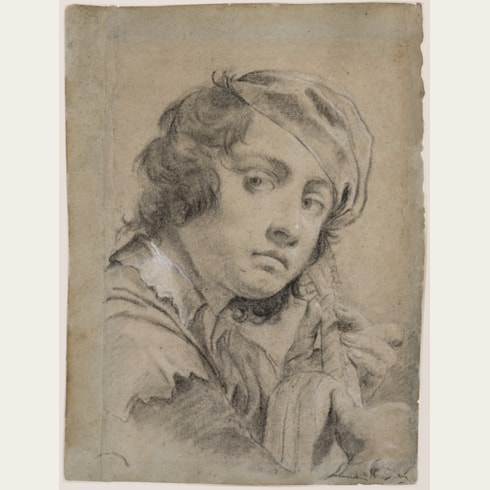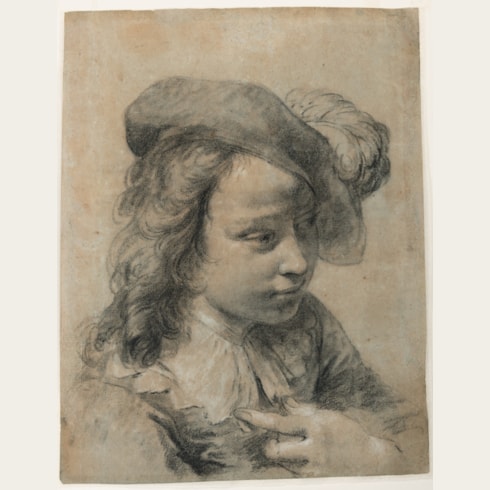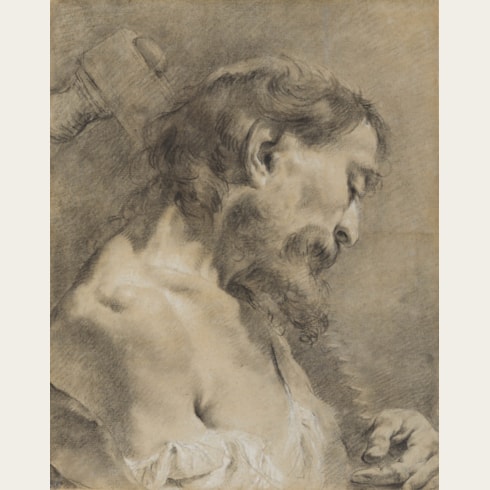Giovanni Battista PIAZZETTA
(Venice 1682 - Vencie 1754)
The Artist’s Son Giacomo Holding a Book
398 x 302 mm. (15 5/8 x 11 7/8 in.)
ACQUIRED BY THE MONTREAL MUSEUM OF FINE ARTS, MONTREAL.
Piazzetta seems to have produced these large, bust-length drawings of character heads as a means of earning a steady income to support himself and his family. Indeed, the 18th century French amateur Antoine-Joseph Dézallier d’Argenville, writing in 1762, noted that Piazzetta claimed to have earned the sum total of 7,000 zecchini from his drawings of heads. Certainly, the fact that the artist’s reputation outside Venice was well established by the early 1720s can be credited to these teste di carattere drawings, many of which were engraved by the Venetian printmaker Marco Pitteri, whose prints served to spread their fame.
While Piazzetta seems to have often used studio assistants or members of his family as models, his teste di carattere drawings are not usually portraits as such. Although very few of these studies of heads are dated, the artist seems to have drawn them throughout his career. George Knox has dated some to the decade of the 1720s, while others may be dated to the 1730s by virtue of the fact that an inventory of the collection of Piazzetta’s patron Marshal Johann Matthias von der Schulenberg notes that the artist supplied several such drawings to him at this time. Further drawings of this type, in which Piazzetta seems to have depicted his children, may be dated to the late 1730s and 1740s; some of these were engraved by Giovanni Cattini and published in 1743 as 'Icones ad vivum expressae' (‘images taken from life’). A large group of Piazzetta’s teste di carattere drawings, numbering thirty-six sheets, once belonged to Consul Joseph Smith – who probably purchased them directly from the artist - and is now in the Royal Library at Windsor Castle.
The young boy depicted in this drawing may be identified as Piazzetta’s eldest son Giacomo Giusto, who was born in December 1725 and would have been about ten years old when the present sheet was drawn. Giacomo appears in a number of his father’s paintings and drawings from the 1730s onwards, notably in such finished genre drawings as Giacomo Feeding a Dog in the Art Institute of Chicago and a Head of a Youth with a Standard in the Ashmolean Museum in Oxford, as well as in drawings in the British Museum, the Cleveland Museum of Art, the National Gallery of Victoria in Melbourne, and elsewhere.
Two closely related, but smaller, versions of this composition of Giacomo holding a book by Piazzetta are known; one among the large group of teste di carattere drawings by the artist in the Royal Library at Windsor Castle, and the other in the collection of the British Museum. Other, similar portraits of Giacomo of c.1735 include a drawing of a Boy with a Raised Hand in the Cleveland Museum of Art and a study of a Boy Holding a Flute, which was in a private collection in Italy in 1956. A similar head of Giacomo also appears, in reverse, in a print by Marco Pitteri after Piazzetta of A Boy with a Dog.
As Catherine Whistler has recently noted of these teste di carattere drawings, ‘Expressive heads or portrait studies in black chalk or charcoal lit up with white were part of Venetian drawing practice, but Piazzetta made this genre his own, with numerous variations featuring young and old, male and female characters...As independent drawings they are poetic images evoking potential narratives, while also presenting Piazzetta’s inventiveness and virtuosity for admiration.’
The present drawing was at one time in the collection of the writer, tutor and art and music critic René de Cérenville (1875-1968). At his death in 1968 he left much of his collection, part of which was inherited from his father Édouard de Cérenville (1843-1915), to the Musée Jenisch in Vevey. The de Cérenville collection included numerous works by both Giambattista and Giandomenico Tiepolo, many of which in turn came from the collection assembled by the Swiss-born Danish diplomat and connoisseur Armand-François-Louis de Mestral de Saint-Saphorin (1738-1806).
Active as a painter, draughtsman, printmaker and book illustrator, Giambattista Piazzetta was first trained by his father, a sculptor, and later was a pupil of Antonio Molinari. A brief stay in Bologna between 1703 and 1705 introduced him to Giuseppe Maria Crespi, whose paintings, like those of Guercino and the Carracci, were to have a particular influence on Piazzetta’s early work. Back in Venice by about 1705, Piazzetta was registered in the Fraglia, the Venetian painter’s guild, by 1711. He worked in Venice for the remainder of his career, painting genre scenes, devotional representations of single saints, portraits and numerous altarpieces for local churches, as well as his only large-scale decoration; the ceiling of Saint Dominic in Glory for the church of SS. Giovanni e Paolo, completed in 1727. He also produced several hundred designs for book illustrations, many of which were commissioned for books issued by the publisher Giovanni Battista Albrizzi, notably an elaborate edition of Torquato Tasso’s epic poem Gerusalemme Liberata that appeared in 1745. By the later part of his career Piazzetta enjoyed considerable renown, both within Venice and abroad, as a draughtsman and painter. In 1754, the year of his death, he was elected principe of the Accademia dei Pittori in Venice.
Provenance
Literature








